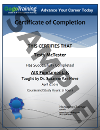Course Description
This course brings together the full meaning of a Lifecycle approach to Service Management. The focus is on the strategy, planning, and measuring ITIL® practices. Understanding and interacting with the lifecycle phase/process/function interactions and interdependencies are crucial to the successful completion of MALC. It is also expected the candidate can apply the high-level concepts of project management and application design, though these concepts are not directly taught during this course.
When PeopleCert offered this exam in English, this course received PeopleCert Accredidation. However, PeopleCert no longer offers this exam in English and therefore GogoTraining no longer pays PeopleCert to list this course as an accredited course. If you are looking to understand ITIL V3 Release, Control & Validation, then this course is a great place to start.
It is highly recommended that students have and study the five core Lifecycle books.
In This Course You Will Learn:
- Key concepts of the service lifecycle
- Communication and stakeholder management
- Integrating service management processes across the service lifecycle
- Managing services across the service lifecycle
- Governance and organization
- Measurement
- Implementing and improving service management capability.
Prerequisites
It is highly recommended that students have taken ITIL Foundation and either the ITIL V3 Lifecycle courses or the ITIL V3 Capability prior to taking the ITIL V3 Managing Across the Lifecycle class.
Outline
Module 00: ITIL®2011: Managing Across the Lifecycle - Course Introduction
Module 01: Service Management and Value
- Student perceptions/definitions of Service Management
- In-depth look at value and value concepts
Module 02: Service Management Components and Roles
- Processes & Functions
- Managing process activities via RACI
Module 03: Key Risk and Knowledge Concepts
- Risk Frameworks
- Measuring, Mitigating and Reporting Risk
- Knowledge management practices to follow, deploy
Module 04: Exercise: MALC Case Study Analysis
- Analyzing the MALC Case Study (v1.1)
- Key Elements
Module 05: Implement, Assess, Improve Service Management
- Add Service Strategy to your Service Management activities
- Strategic Assessments (SWOT)
- Strategic Assessment Steps
Module 06: Assessment Frameworks
- Discussion of several Assessment frameworks:
- ITIL® maturity assessments
- ISO/IEC 20000
- COBIT
- Six Sigma
- CMMI
- Gap Analysis
- Benchmarking
- Compare/contrast the various models
- Deming Cycle
Module 07: 7-Step Improvement Process
- The 7 steps
- Justifying improvements with a Business Case
Module 08: Justifying Improvements Financially
- ROI: Pre- and Post-Program
- Screening and Preference Decisions
- CSI & ROI
Module 09: Managing Organizational Change
- Impact of improvements
- Organizational Change via Kotter and others
- Plan/implement Service Management Technologies
Module 10: Exercise: Develop Assessment Criteria
- Assignment of Develop Assessment Criteria
- MALC Sample Exam Questions
Module 11: Exercise Review: MALC Sample Exam Questions
- Sample Paper 1: Question 1
- Sample Paper 2: Question 6
Module 12: Measurements: Metrics
- Measuring Business Value
- Metrics…in Review
- Service Measurement Models
- Designing Measurement Systems
Module 13: Measurements: Monitor, Control & Report
- Monitor & Control Systems (Monitoring Loops)
- Types of Reporting based on Monitoring
- Ties to Event Management
Module 14: Exercise: Applying Assessment Criteria
- Review of Developing Assessment Criteria
- Assignment of Applying Assessment Criteria
Module 15: Integration: Strategic Benefits
- Ensuring strategic benefits
- Building Strategic Benefits into other processes/phases
Module 16: Integration: Lifecycle and Phase Inputs & Outputs
- Generic Lifecycle inputs/outputs
- Specific inputs/outputs per lifecycle phase
- Handout: Inputs/Outputs v1
Module 17: Integration: Value to the Business Part 1
- Service Management Processes Demonstrating Value
- Value to the Business – Service Strategy & Service Design
Module 18: Integration: Value to the Business Part 2
- Service Management Processes Demonstrating Value
- Value to the Business – Service Transition, Service Operation & CSI
Module 19: Integration: Process Interfaces
- Interfaces between all Service Management processes
- Handout: Process Interface Diagram v1
Module 20: Exercise: Internet Banking Risks
- Review of Applying Assessment Criteria
- Assignment of Internet Banking Risks
- Exercise Sample Exam Questions
Module 21: Exercise Review: MALC Sample Exam Questions
- Sample Paper 1: Question 6
- Sample Paper 2: Question 8
Module 22: Managing Services: Requirements & Cross-Lifecycle Support
- Managing requirements
- The SDP
- Cross-lifecycle, cross-support
- Improvements
- Handout: Customer & Users Measuring Satisfaction v1
- Handout: Satisfaction Survey Types v1
Module 23: Managing Services: Challenges, Risks, CSFs Part 1
- Challenges and Risks for SS, SD, ST
- CSFs for SS, SD, ST
Module 24: Managing Services: Challenges, Risks, CSFs Part 2
- Challenges, Risks and CSFs for SS, SD, ST
- What is your Top 10 list of challenges, risks, CSFs?
Module 25: Exercise: Where’s the value?
- Review of Internet Banking Risks
- Assignment of “Where’s the value?”
- MALC Sample Exam Questions
Module 26: Exercise Review: MALC Sample Exam Questions
- Sample Paper 1: Question 3
- Sample Paper 2: Question 2
Module 27: Governance
- What is governance? How is it defined? ISO/IEC 38500
- Where IT (or business) governance is managed – the ISG
- Management Systems
- Sourcing and Change Governance
Module 28: Organizational Structures
- Centralized vs. Decentralized Spectrum
- Organizational Development
- Organization Structures
Module 29: Organizing Service Management
- Organizing the Lifecycle phases – Considerations
- Competencies of Staff
- Service Provider Types
- Organizing Service Delivery
- Handout: Advantages/Disadvantages of Sourcing Structures v1
Module 30: Exercise: “We’ve been outsourced!”
- Review of “Where’s the value?”
- Assignment of “We’ve been outsourced!”
Module 31: Stakeholder Management
- Service Management Stakeholders
- BRM: Managing Stakeholders
- BRM Lifecycle Activities & Roles
Module 31: Communication
- Communication through the Lifecycle Phases
Module 33: Exercise: Communicating Change
- Review of “We’ve been outsourced!”
- Assignment of Communicating Change
- MALC Sample Exam Questions
Module 34: Exercise Review: MALC Sample Exam Questions
- Review of Communicating Change
- Sample Paper 1: Question 2
- Sample Paper 2: Question
How can we help? Customer Service is standing by to answer your questions.


